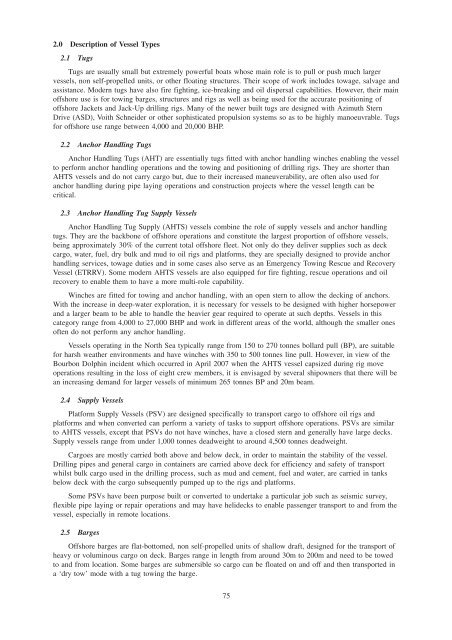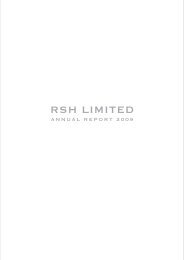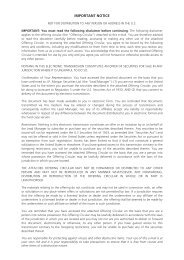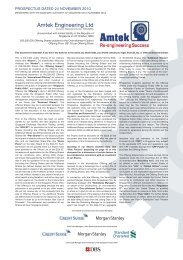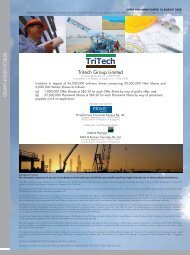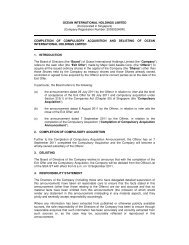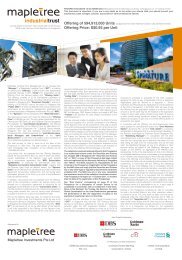O TTO M ARINE L IMITED - Microsoft Internet Explorer - SGX
O TTO M ARINE L IMITED - Microsoft Internet Explorer - SGX
O TTO M ARINE L IMITED - Microsoft Internet Explorer - SGX
You also want an ePaper? Increase the reach of your titles
YUMPU automatically turns print PDFs into web optimized ePapers that Google loves.
2.0 Description of Vessel Types<br />
2.1 Tugs<br />
Tugs are usually small but extremely powerful boats whose main role is to pull or push much larger<br />
vessels, non self-propelled units, or other floating structures. Their scope of work includes towage, salvage and<br />
assistance. Modern tugs have also fire fighting, ice-breaking and oil dispersal capabilities. However, their main<br />
offshore use is for towing barges, structures and rigs as well as being used for the accurate positioning of<br />
offshore Jackets and Jack-Up drilling rigs. Many of the newer built tugs are designed with Azimuth Stern<br />
Drive (ASD), Voith Schneider or other sophisticated propulsion systems so as to be highly manoeuvrable. Tugs<br />
for offshore use range between 4,000 and 20,000 BHP.<br />
2.2 Anchor Handling Tugs<br />
Anchor Handling Tugs (AHT) are essentially tugs fitted with anchor handling winches enabling the vessel<br />
to perform anchor handling operations and the towing and positioning of drilling rigs. They are shorter than<br />
AHTS vessels and do not carry cargo but, due to their increased maneuverability, are often also used for<br />
anchor handling during pipe laying operations and construction projects where the vessel length can be<br />
critical.<br />
2.3 Anchor Handling Tug Supply Vessels<br />
Anchor Handling Tug Supply (AHTS) vessels combine the role of supply vessels and anchor handling<br />
tugs. They are the backbone of offshore operations and constitute the largest proportion of offshore vessels,<br />
being approximately 30% of the current total offshore fleet. Not only do they deliver supplies such as deck<br />
cargo, water, fuel, dry bulk and mud to oil rigs and platforms, they are specially designed to provide anchor<br />
handling services, towage duties and in some cases also serve as an Emergency Towing Rescue and Recovery<br />
Vessel (ETRRV). Some modern AHTS vessels are also equipped for fire fighting, rescue operations and oil<br />
recovery to enable them to have a more multi-role capability.<br />
Winches are fitted for towing and anchor handling, with an open stern to allow the decking of anchors.<br />
With the increase in deep-water exploration, it is necessary for vessels to be designed with higher horsepower<br />
and a larger beam to be able to handle the heavier gear required to operate at such depths. Vessels in this<br />
category range from 4,000 to 27,000 BHP and work in different areas of the world, although the smaller ones<br />
often do not perform any anchor handling.<br />
Vessels operating in the North Sea typically range from 150 to 270 tonnes bollard pull (BP), are suitable<br />
for harsh weather environments and have winches with 350 to 500 tonnes line pull. However, in view of the<br />
Bourbon Dolphin incident which occurred in April 2007 when the AHTS vessel capsized during rig move<br />
operations resulting in the loss of eight crew members, it is envisaged by several shipowners that there will be<br />
an increasing demand for larger vessels of minimum 265 tonnes BP and 20m beam.<br />
2.4 Supply Vessels<br />
Platform Supply Vessels (PSV) are designed specifically to transport cargo to offshore oil rigs and<br />
platforms and when converted can perform a variety of tasks to support offshore operations. PSVs are similar<br />
to AHTS vessels, except that PSVs do not have winches, have a closed stern and generally have large decks.<br />
Supply vessels range from under 1,000 tonnes deadweight to around 4,500 tonnes deadweight.<br />
Cargoes are mostly carried both above and below deck, in order to maintain the stability of the vessel.<br />
Drilling pipes and general cargo in containers are carried above deck for efficiency and safety of transport<br />
whilst bulk cargo used in the drilling process, such as mud and cement, fuel and water, are carried in tanks<br />
below deck with the cargo subsequently pumped up to the rigs and platforms.<br />
Some PSVs have been purpose built or converted to undertake a particular job such as seismic survey,<br />
flexible pipe laying or repair operations and may have helidecks to enable passenger transport to and from the<br />
vessel, especially in remote locations.<br />
2.5 Barges<br />
Offshore barges are flat-bottomed, non self-propelled units of shallow draft, designed for the transport of<br />
heavy or voluminous cargo on deck. Barges range in length from around 30m to 200m and need to be towed<br />
to and from location. Some barges are submersible so cargo can be floated on and off and then transported in<br />
a ‘dry tow’ mode with a tug towing the barge.<br />
75


